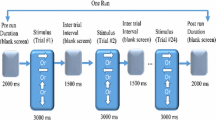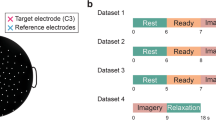Abstract
Phase-locking value (PLV) is a potentially useful feature in sensorimotor rhythm-based brain–computer interface (BCI). However, volume conduction may cause spurious zero-phase coupling between two EEG signals and it is not clear whether PLV effects are independent of spectral amplitude. Volume conduction might be reduced by spatial filtering, but it is uncertain what impact this might have on PLV. Therefore, the goal of this study was to explore whether zero-phase PLV is meaningful and how it is affected by spatial filtering. Both amplitude and PLV feature were extracted in the frequency band of 10–15 Hz by classical methods using archival EEG data of 18 subjects trained on a two-target BCI task. The results show that with right ear-referenced data, there is meaningful long-range zero-phase synchronization likely involving the primary motor area and the supplementary motor area that cannot be explained by volume conduction. Another novel finding is that the large Laplacian spatial filter enhances the amplitude feature but eliminates most of the phase information seen in ear-referenced data. A bipolar channel using phase-coupled areas also includes both phase and amplitude information and has a significant practical advantage since fewer channels required.





Similar content being viewed by others
References
Andrew C, Pfurtscheller G (1996) Event-related coherence as a tool for studying dynamic interaction of brain regions. Electroencephalogr Clin Neurophysiol 98:144–148. doi:10.1016/0013-4694(95)00228-6
Andrew C, Pfurtscheller G (1997) On the existence of different alpha band rhythms in the hand area of man. Neurosci Lett 222:103–106. doi:10.1016/S0304-3940(97)13358-4
Andrew C, Pfurtscheller G (1996) Dependence of coherence measurements on EEG derivation type. Med Biol Eng Comput 34:232–238. doi:10.1007/BF02520079
Bastos AM, Vezoli J, Fries P (2015) Communication through coherence with inter-areal delays. Curr Opin Neurobiol 31:173–180. doi:10.1016/j.conb.2014.11.001
Bayraktaroglu Z, von Carlowitz-Ghori K, Curio G, Nikulin VV (2013) It is not all about phase: amplitude dynamics in corticomuscular interactions. NeuroImage 64:496–504. doi:10.1016/j.neuroimage.2012.08.069
Brunner C, Scherer R, Graimann B, Supp G, Pfurtscheller G (2006) Online control of a brain–computer interface using phase synchronization. IEEE Trans Biomed Eng 53:2501–2506. doi:10.1109/TBME.2006.881775
Celka P (2007) Statistical analysis of the phase-locking value. IEEE Signal Process Lett 14:577–580. doi:10.1109/LSP.2007.896142
Chawla D, Friston KJ, Lumer ED (2001) Zero-lag synchronous dynamics in triplets of interconnected cortical areas. Neural Netw 14:727–735. doi:10.1016/S0893-6080(01)00043-0
Daffertshofer A, van Wijk BCM (2011) On the influence of amplitude on the connectivity between phases. Front Neuroinformatics 5:6. doi:10.3389/fninf.2011.00006
Flandrin P, Rilling G, Goncalves P (2004) Empirical mode decomposition as a filter bank. IEEE Signal Process Lett 11:112–114. doi:10.1109/LSP.2003.821662
Florian G, Andrew C, Pfurtscheller G (1998) Do changes in coherence always reflect changes in functional coupling? Electroencephalogr Clin Neurophysiol 106:87–91. doi:10.1016/S0013-4694(97)00105-3
Gollo LL, Mirasso C, Sporns O, Breakspear M (2014) Mechanisms of zero-lag synchronization in cortical motifs. PLoS Comput Biol 10:e1003548. doi:10.1371/journal.pcbi.1003548
Huang NE, Shen Z, Long SR, Wu MC, Shih HH, Zheng Q, Yen N-C, Tung CC, Liu HH (1998) The empirical mode decomposition and the Hilbert spectrum for nonlinear and non-stationary time series analysis. Proc R Soc Lond Math Phys Eng Sci 454:903–995. doi:10.1098/rspa.1998.0193
Krusienski DJ (2009) A method for visualizing independent spatio-temporal patterns of brain activity. EURASIP J Adv Signal Process 2009:948961. doi:10.1155/2009/948961
Krusienski DJ, McFarland DJ, Wolpaw JR (2012) Value of amplitude, phase, and coherence features for a sensorimotor rhythm-based brain–computer interface. Brain Res Bull 87:130–134. doi:10.1016/j.brainresbull.2011.09.019
Lachaux JP, Rodriguez E, Martinerie J, Varela FJ (1999) Measuring phase synchrony in brain signals. Hum Brain Mapp 8:194–208
Le Van Quyen M, Foucher J, Lachaux J-P, Rodriguez E, Lutz A, Martinerie J, Varela FJ (2001) Comparison of Hilbert transform and wavelet methods for the analysis of neuronal synchrony. J Neurosci Methods 111:83–98. doi:10.1016/S0165-0270(01)00372-7
Leocani L, Toro C, Manganotti P, Zhuang P, Hallett M (1997) Event-related coherence and event-related desynchronization/synchronization in the 10 Hz and 20 Hz EEG during self-paced movements. Electroencephalogr Clin Neurophysiol Potentials Sect 104:199–206. doi:10.1016/S0168-5597(96)96051-7
Lou B, Hong B, Gao X, Gao S (2008) Bipolar electrode selection for a motor imagery based brain–computer interface. J Neural Eng 5:342. doi:10.1088/1741-2560/5/3/007
McFarland DJ (2015) The advantages of the surface Laplacian in brain–computer interface research. Int J Psychophysiol 97:271–276. doi:10.1016/j.ijpsycho.2014.07.009
McFarland DJ, Lefkowicz AT, Wolpaw JR (1997) Design and operation of an EEG-based brain–computer interface with digital signal processing technology. Behav Res Methods Instrum Comput 29:337–345. doi:10.3758/BF03200585
McFarland DJ, McCane LM, David SV, Wolpaw JR (1997) Spatial filter selection for EEG-based communication. Electroencephalogr Clin Neurophysiol 103:386–394. doi:10.1016/S0013-4694(97)00022-2
McFarland DJ, Sarnacki WA, Vaughan TM, Wolpaw JR (2005) Brain–computer interface (BCI) operation: signal and noise during early training sessions. Clin Neurophysiol 116:56–62. doi:10.1016/j.clinph.2004.07.004
McFarland DJ, Wolpaw JR (2003) EEG-based communication and control: speed–accuracy relationships. Appl Psychophysiol Biofeedback 28:217–231. doi:10.1023/A:1024685214655
Miskovic V, Schmidt LA, Boyle M, Saigal S (2009) Regional electroencephalogram (EEG) spectral power and hemispheric coherence in young adults born at extremely low birth weight. Clin Neurophysiol 120:231–238. doi:10.1016/j.clinph.2008.11.004
Moll K, Hasko S, Groth K, Bartling J, Schulte-Körne G (2016) Letter-sound processing deficits in children with developmental dyslexia: an ERP study. Clin Neurophysiol 127:1989–2000. doi:10.1016/j.clinph.2016.01.005
Mylonas DS, Siettos CI, Evdokimidis I, Papanicolaou AC, Smyrnis N (2015) Modular patterns of phase desynchronization networks during a simple visuomotor task. Brain Topogr 29:118–129. doi:10.1007/s10548-015-0451-5
Nolte G, Bai O, Wheaton L, Mari Z, Vorbach S, Hallett M (2004) Identifying true brain interaction from EEG data using the imaginary part of coherency. Clin Neurophysiol 115:2292–2307. doi:10.1016/j.clinph.2004.04.029
Nunez PL, Silberstein RB, Shi Z, Carpenter MR, Srinivasan R, Tucker DM, Doran SM, Cadusch PJ, Wijesinghe RS (1999) EEG coherency II: experimental comparisons of multiple measures. Clin Neurophysiol 110:469–486. doi:10.1016/S1388-2457(98)00043-1
Nunez PL, Srinivasan R, Westdorp AF, Wijesinghe RS, Tucker DM, Silberstein RB, Cadusch PJ (1997) EEG coherency: i: statistics, reference electrode, volume conduction, Laplacians, cortical imaging, and interpretation at multiple scales. Electroencephalogr Clin Neurophysiol 103:499–515. doi:10.1016/S0013-4694(97)00066-7
Peraza LR, Asghar AUR, Green G, Halliday DM (2012) Volume conduction effects in brain network inference from electroencephalographic recordings using phase lag index. J Neurosci Methods 207:189–199. doi:10.1016/j.jneumeth.2012.04.007
Pfurtscheller G, Lopes da Silva FH (1999) Event-related EEG/MEG synchronization and desynchronization: basic principles. Clin Neurophysiol 110:1842–1857. doi:10.1016/S1388-2457(99)00141-8
Rappelsberger P, Pfurtscheller G, Filz O (1994) Calculation of event-related coherence—a new method to study short-lasting coupling between brain areas. Brain Topogr 7:121–127. doi:10.1007/BF01186770
Schalk G, McFarland DJ, Hinterberger T, Birbaumer N, Wolpaw JR (2004) BCI2000: a general-purpose brain–computer interface (BCI) system. IEEE Trans Biomed Eng 51:1034–1043. doi:10.1109/TBME.2004.827072
Sharbrough F, Chatrian CE, Lesser RP, Luders H, Nuwer M and Picton TW (1991) American electroencephalographic society guidelines for standard electrode position nomenclature. J Clin Neurophysiol 8:200–202
Sheikh H, McFarland DJ, Sarnacki WA, Wolpaw JR (2003) Electroencephalographic(EEG)-based communication: EEG control versus system performance in humans. Neurosci Lett 345:89–92. doi:10.1016/S0304-3940(03)00470-1
Simpson EV, Ideker RE, Cabo C, Yabe S, Zhou X, Melnick SB, Smith WM (1993) Evaluation of an automatic cardiac activation detector for bipolar electrograms. Med Biol Eng Comput 31:118–128. doi:10.1007/BF02446669
Spiegler A, Graimann B, Pfurtscheller G (2004) Phase coupling between different motor areas during tongue-movement imagery. Neurosci Lett 369:50–54. doi:10.1016/j.neulet.2004.07.054
Stam CJ, Nolte G, Daffertshofer A (2007) Phase lag index: assessment of functional connectivity from multi channel EEG and MEG with diminished bias from common sources. Hum Brain Mapp 28:1178–1193. doi:10.1002/hbm.20346
Tenke CE, Kayser J (2012) Generator localization by current source density (CSD): implications of volume conduction and field closure at intracranial and scalp resolutions. Clin Neurophysiol 123:2328–2345. doi:10.1016/j.clinph.2012.06.005
Tenke CE, Kayser J (2015) Surface Laplacians (SL) and phase properties of EEG rhythms: simulated generators in a volume-conduction model. Int J Psychophysiol 97:285–298. doi:10.1016/j.ijpsycho.2015.05.008
Vollebregt MA, Zumer JM, ter Huurne N, Buitelaar JK, Jensen O (2016) Posterior alpha oscillations reflect attentional problems in boys with attention deficit hyperactivity disorder. Clin Neurophysiol 127:2182–2191. doi:10.1016/j.clinph.2016.01.021
Wang Y, Hong B, Gao X, Gao S (2006) Phase synchrony measurement in motor cortex for classifying single-trial EEG during motor imagery. IEEE, pp 75–78
Wang Y, Hong B, Gao X, Gao S (2007) Design of electrode layout for motor imagery based brain–computer interface. Electron Lett 43:557. doi:10.1049/el:20070563
Wei Q, Wang Y, Gao X, Gao S (2007) Amplitude and phase coupling measures for feature extraction in an EEG-based brain–computer interface. J Neural Eng 4:120. doi:10.1088/1741-2560/4/2/012
Witham CL, Wang M, Baker SN (2007) Cells in somatosensory areas show synchrony with beta oscillations in monkey motor cortex. Eur J Neurosci 26:2677–2686. doi:10.1111/j.1460-9568.2007.05890.x
Wolpaw JR, Birbaumer N, McFarland DJ, Pfurtscheller G, Vaughan TM (2002) Brain–computer interfaces for communication and control. Clin Neurophysiol 113:767–791. doi:10.1016/S1388-2457(02)00057-3
Zhou Z, Wan B, Ming D, Qi H (2010) A novel technique for phase synchrony measurement from the complex motor imaginary potential of combined body and limb action. J Neural Eng 7:46008. doi:10.1088/1741-2560/7/4/046008
Acknowledgements
This work was supported in part by the National Institutes of Health (NIH) (Grants HD30146 46) (NCMRR/NICHD), EB00856 (NIBIB &NINDS), National “111” Project (B08036) and in part by the China Scholarship Council. The authors would like to thank Jonathan Carp and Li Zhang for their helpful comments on an earlier version of this paper.
Author information
Authors and Affiliations
Corresponding author
Electronic supplementary material
Below is the link to the electronic supplementary material.
Rights and permissions
About this article
Cite this article
Jian, W., Chen, M. & McFarland, D.J. Use of phase-locking value in sensorimotor rhythm-based brain–computer interface: zero-phase coupling and effects of spatial filters. Med Biol Eng Comput 55, 1915–1926 (2017). https://doi.org/10.1007/s11517-017-1641-y
Received:
Accepted:
Published:
Issue Date:
DOI: https://doi.org/10.1007/s11517-017-1641-y




